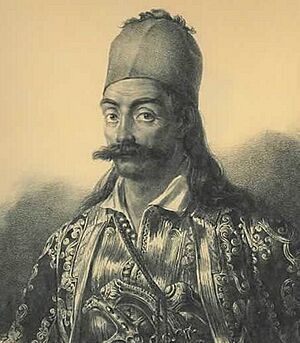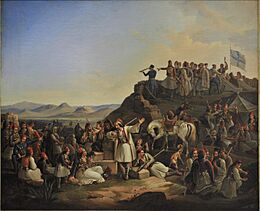Georgios Karaiskakis facts for kids
Quick facts for kids
Georgios Karaiskakis
|
|
|---|---|

Georgios Karaiskakis; lithography by Karl Krazeisen.
|
|
| Native name |
Γεώργιος Καραϊσκάκης
|
| Birth name | Georgios Karaiskos Γεώργιος Καραΐσκος |
| Nickname(s) | The Nun's Son |
| Born | January 23 1782 Mavrommati, Karditsa, Ottoman Empire (now Greece) |
| Died | 23 April 1827 (aged 45) Phaleron, Attica, Ottoman Empire (now Greece) |
| Buried |
Agios Demetrios church, Salamis
|
| Allegiance | |
| Service/ |
|
| Years of service | 1796–1827 |
| Battles/wars |
|
| Awards | |
| Spouse(s) | Engolpia Skylodimou |
| Children | Pinelopi Karaiskaki (daughter) Eleni Karaiskaki (daughter) Spyridon Karaiskakis (son) Dimitrios Karaiskakis (son) |
| Relations | Sitsa Karaiskaki |
| Other work | Body guard of Ali Pasha |
| Signature | |
Georgios Karaiskakis (Greek: Γεώργιος Καραϊσκάκης), born Georgios Karaiskos (Greek: Γεώργιος Καραΐσκος; 1782 – 1827), was a brave Greek military leader. He played a very important role in the Greek War of Independence, helping Greece gain its freedom from the Ottoman Empire.
Contents
Early Life and Training
Georgios Karaiskakis was born in 1782. His family belonged to the Sarakatsani people. His father, Dimitris Iskos, was an armatolos, which was like a local military leader who kept order for the Ottomans. His mother was Zoe Dimiski.
There is some discussion about where Karaiskakis was born. Some say it was at a monastery in Skoulikaria, while others believe it was in a cave near Mavrommati. A special committee decided in 1927 that Mavrommati was his birthplace.
Becoming a Klepht
When he was very young, Karaiskakis became a klepht. Klephts were groups of Greek fighters who lived in the mountains and fought against Ottoman rule. He joined a famous klepht captain named Katsantonis. Karaiskakis quickly showed his skills and became a protopalikaro, which means a top lieutenant or second-in-command.
Serving Ali Pasha
At age fifteen, Karaiskakis was captured by the forces of Ali Pasha of Ioannina, a powerful Albanian ruler. He was put in prison in Ioannina. Ali Pasha was impressed by Karaiskakis's courage and intelligence. He released him and made him a member of his personal bodyguards.
While serving Ali Pasha, Karaiskakis gained valuable military experience. He fought against another Ottoman warlord, Osman Pazvantoğlu, in 1798.
Leading in the Greek War of Independence
Karaiskakis fought with Ali Pasha in his war against the Ottomans from 1820 to 1822. After Ali Pasha was defeated and died, Karaiskakis joined the Greek rebels.

In July 1821, he joined the Greek fighters in the Battle of Komboti. Soon after, he aimed to take control of the armatolik (military district) of Agrafa. He gathered many supporters and successfully took over Agrafa. Even the Ottoman authorities recognized him as the leader there because they were busy fighting the Greek uprising in other areas.
Fighting for Freedom
Even though the Ottomans recognized him, Karaiskakis attacked their army in early 1823. This Ottoman army was retreating from the failed First Siege of Missolonghi. Karaiskakis defeated a large group of 3,000 soldiers near Agios Vlasios.
Later, when Mustafa Pasha arrived in Larissa, he ordered Karaiskakis to meet him. Instead, Karaiskakis, who was very ill, left Agrafa with about 300 men. He went to Prousos Monastery to get better. His men joined other Greek fighters and fought in the Battle of Karpenisi. Because his health did not improve, Karaiskakis went to Ithaca, which was then ruled by the British, to see doctors.
Key Victories and Challenges
Karaiskakis became more and more famous as the war continued. He helped during the Second Siege of Missolonghi in 1823. He also tried his best to save the town during its third siege in 1826.
In 1826, he was made the commander-in-chief of the Greek revolutionary forces in Central Greece. He had some successes against the Ottomans, but it was sometimes hard for him to work with other Greek leaders.
His most famous victory was the Battle of Arachova. In this battle, his forces completely defeated a large group of Turkish and Albanian soldiers.
In 1827, Karaiskakis took part in the effort to end the siege of Athens. He also participated in the attack on the Ottoman soldiers stationed in the Saint Spyridon convent in Piraeus.
Death in Battle
Georgios Karaiskakis was killed in action on April 23, 1827. He was fatally wounded by a rifle bullet during the Battle of Phaleron. He was buried in the church of Saint Dimitrios on Salamis, just as he had wished.
Family Life
Karaiskakis was married to Engolpia Skylodimou. They had four children: two daughters named Pinelopi and Eleni, and two sons named Spyridon and Dimitrios.
See also
- Armatoloi
- Dimitrios Makris
Images for kids


